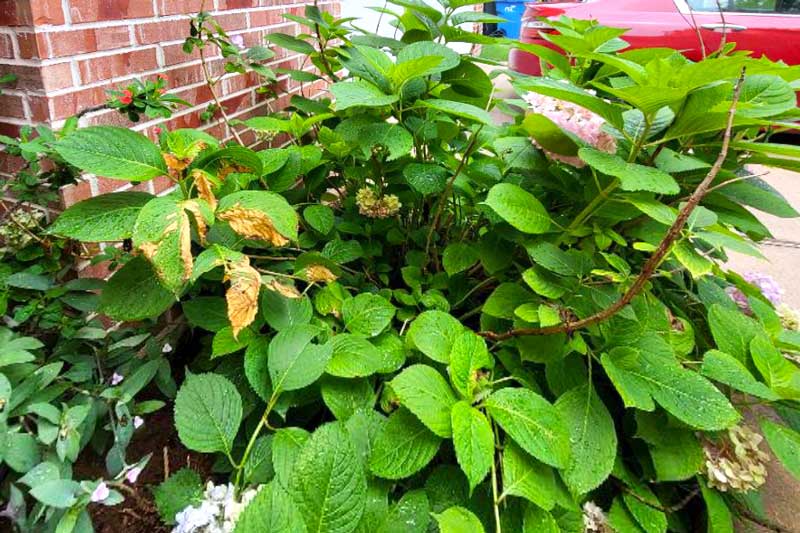Q&A – Ask Neil: June 13, 2024
(Please read these instructions carefully.)
Before you post your question, please look at recent issues to see if someone else has already asked it. You might find your answer there.
How to submit your question…
(Note: You may need to allow a pop-up window to come up in order to get the link for sending your photo(s). If you have already submitted your question and didn’t see the pop-up window, please click here.)
• Click the link provided below to post your question. After you submit your question, a new window will pop up giving you the address to which you can e-mail a SHARP, HIGH-RESOLUTION PHOTO to accompany your question. Please DO NOT SEND THUMBNAIL PHOTOS in case I need to zoom in to see things.
• Click here to post your question.
• Please ONLY POST YOUR QUESTION ONE TIME. We can only accept a set number of questions each week, and when we get duplicates it costs other people their chances.
• One question per reader, please.
• Please use this only for posting questions – not for standard emails.
• Watch for your answer in the following week’s e-gardens.
• I choose those of greatest general interest. For example, plant IDs seldom make the cut.
• I must have your first name or initials.
• I must have your city or county. (Texas is a very large state.)
QUESTION 1
IS IT TOO LATE TO DRENCH FOR CRAPE MYRTLE BARK SCALE?
Question: As per directions, I’ve applied a drench of Imidicloprid on my crape myrtle for two years in early May. The ground has been so saturated, I haven’t done it yet. Should I wait until a few days after the rain stops, or should I do it soon regardless? Chris R., Dallas County.
Answer: Since you wrote your note a few days ago things have taken a slight turn toward the dry side. You may have drenched the ground by now. If so, that’s fine, although Texas A&M research has shown that the earlier (mid-May) time is better. However, I have another way of looking at it. I live where crape myrtle bark scale was first observed in the U.S. (Collin County) 20 years ago, and it appears to my eye that the scale has not been nearly as bad in recent years as it was in 2007 and a couple of other earlier years. I haven’t seen much on the plants I’ve observed this year so far in our (your and my) area. You might lay off this year and see if your treatments combined with natural predators in your neighborhood have combined to get bark scale numbers back in check. It would be good to know. It’s highly possible that we’ll get to a point where we don’t have to treat every year.
QUESTION 2
WHY DO MY MORNING GLORIES KEEP GETTING SPIDER MITES EVERY YEAR?
Question: Why do my morning glories keep getting spider mites every year about now? I’ve tried spraying with a labeled product from a reputable local nursery, but without results. The leaves still look bad. What can I do? Brian W., Lucas.
Answer: Spider mites are the most damaging pest (not really an insect) that we have in Texas landscapes and gardens. They’re nearly microscopic, yet they can do untold damage to myriad crops. Morning glories, as you’ve observed, are one of their favorite host plants, along with beans, tomatoes, marigolds, and a host of annuals and perennials, even houseplants and junipers. The list goes on and on. There are many products labeled for control of “spider mites,” “red spiders,” and “two-spotted red spider mites” (you’re likely to see any of those names on the containers) on the market. However, they are constantly hatching from eggs, so you’ll need to reapply weekly to get reliable control. You’ll also need to start your sprays early in the mite season, before they get out of hand. And you’ll need to be careful to spray both the top and bottom leaf surfaces. They hang out both places. It is possible to keep them under control. You must stay after them.
QUESTION 3
WHAT IS HAPPENING TO OUR BIGLEAF HYDRANGEA?
Question: What is happening to our bigleaf hydrangea? Many leaves are starting to show damage. You’ll see the most obvious one if you zoom in. David Y., Rowlett.
Answer: I actually can’t tell which leaf you might be calling “the most obvious one.” I see several with holes probably caused by hail of the past several weeks. Then I also see several with brown deteriorated tissues probably brought on by moisture on the leaves when the sun hit them – could be fungal (I can’t really tell). I would selectively trim off the dead stem and damaged growth and apply a high-nitrogen lawn-type fertilizer with no type of weedkiller included. Water it in deeply and watch the plant produce its new growth for this season.
QUESTION 4
IS THIS THE BEGINNING OF THE END FOR MY 35-YEAR-OLD EASTERN REDCEDAR?
Question: I have a fungus growing in and on the trunk of my 35-year-old eastern redcedar. I have been told this is the beginning of the end for the tree. Do you agree? Tom C., Flower Mound.
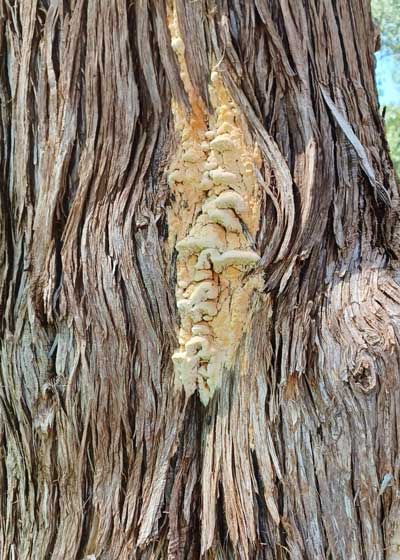
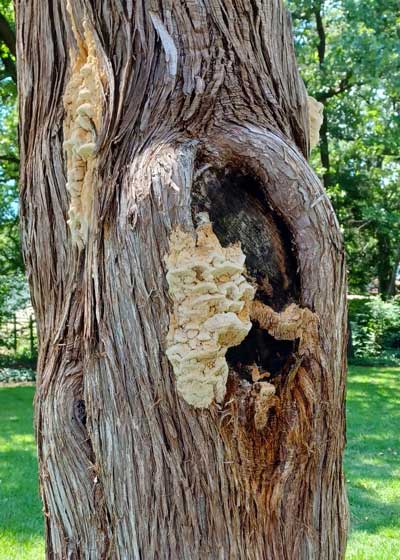
Answer: I have the same fungus growing within one of my own redcedars. It’s been there for more than 10 years. I reached out to my friends (and advertisers) with Arborilogical Services to ask their experiences with this. A former Texas State Arborist of the Year Russell Peters, one of their top arborists with a Master’s Degree in Plant Pathology, says “It’s a wood decay fungus that is not a significant threat to the tree long-term.” So, it looks like you and I will get to enjoy our redcedars for a good while longer.
QUESTION 5
IS BROWNING DUE TO TOO MUCH FERTILIZER, OR IS DISEASE INVOLVED?
Question: My holly’s leaves have brown-black margins and black spots along their outer edges. All of this season’s new leaves are in this condition. Many of them have fallen. I applied a slow-release fertilizer in April. It did not contain a weedkiller. Did I apply too much fertilizer? Denise K., McKinney.
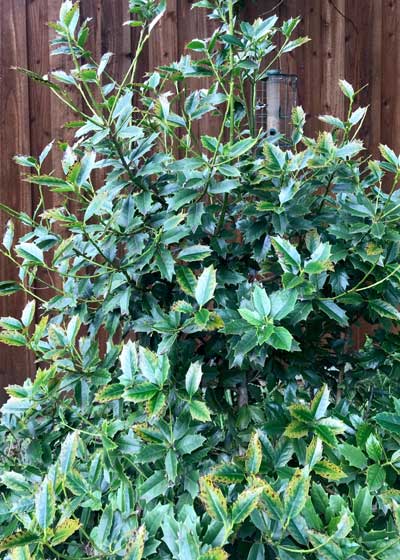
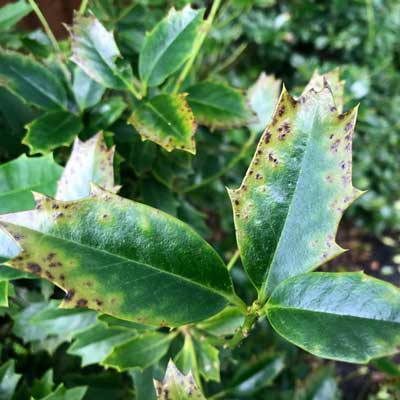
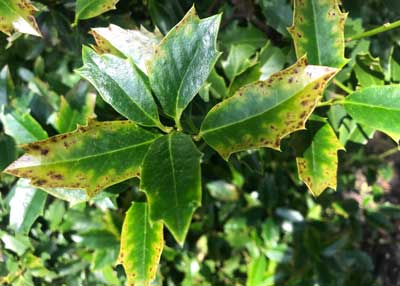
Answer: Anytime any plant’s leaves turn brown or black around their tips and edges that’s a sign of moisture stress. Those tips and edges are the places that are farthest from the roots, so they dry out first and get water last. In that context, the browning could have been caused by too much fertilizer if it was applied with too little water to dilute it. In that event it becomes a super-concentrated salt solution that actually pulls water back out of the root cells. So, that’s one possibility. But letting the plant get too dry would have the same effect. That probably hasn’t happened in the past 8 weeks, but perhaps it happened earlier in the spring. I do see a few spots that look like they might be fungal, but diseases do not cluster around leaf edges like this, so I’m not going to recommend spraying with a fungicide unless you already have one on hand and just want to give it a try. I would suggest keeping the plant moist the rest of the summer so that there is no more moisture stress. If you decide to fertilize it again, use a water-soluble, high-nitrogen food just one time in early September. Otherwise, leave it alone.
QUESTION 6
WHAT ARE THESE SPOTS ON MY OAKLEAF HYDRANGEA?
Question: This oakleaf hydrangea was planted 4 weeks ago in partial shade. What has caused these spots? Terry C., Dennis, Parker County.
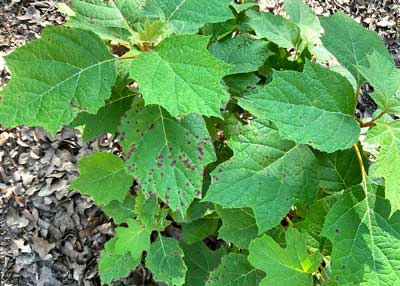
Answer: This might be fungal in origin, but I have to confess – I looked right past it. Look at the new leaves. They’re clean and great looking. If this were a serious fungal disease, it would have been spreading quickly to them. I see no cause for concern. These plants need constant moisture – not wet, but certainly never dry to the point of wilting in the heat of the summer. Keep a close eye on it and water it as needed. While you’re doing that, watch to see if any spots appear on growth that is currently “clean.” If it does, that’s the time to get out the fungicide right away. I’ll bet you never need it.

